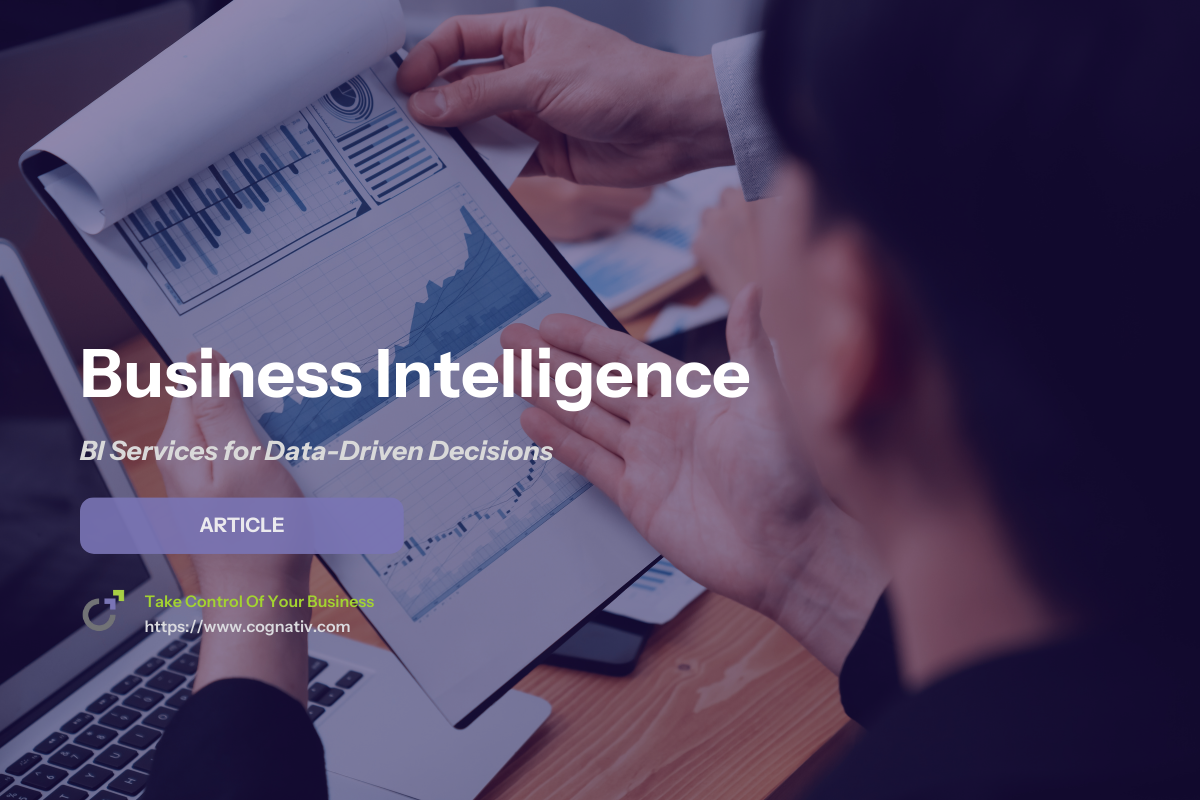Business Intelligence Services for Data-Driven Decisions
Business intelligence services empower organizations to transform data into insightful decisions. They integrate, analyze, and visualize data, providing a comprehensive view of operations and supporting strategic planning. In this article, we’ll dive into what business intelligence services are, the key components involved, and how they can enhance your business processes.
Key Takeaways
-
Business intelligence services are essential for integrating and analyzing data, allowing organizations to make informed, data-driven decisions that enhance operational efficiency.
-
Key components of effective BI solutions include data analytics, integration, visualization, data warehousing, and predictive analytics, which collectively provide a comprehensive view of business operations.
-
Successful implementation of BI solutions requires careful planning, user training, and addressing common challenges such as data quality management and user adoption to ensure reliable insights and effective utilization.
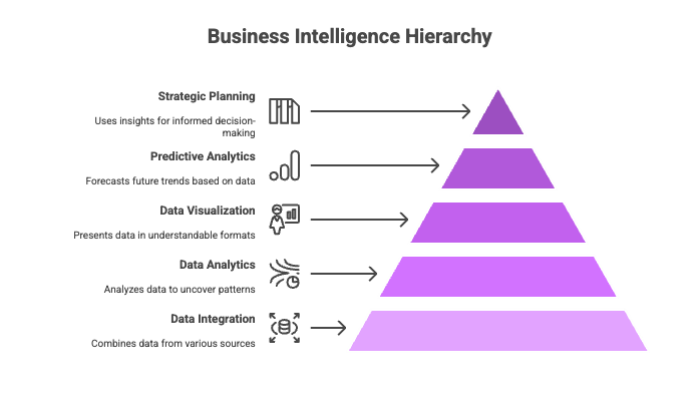

Understanding Business Intelligence Services
Business intelligence services help organizations extract knowledge from data, integrate it, and turn it into insights. These services enable organizations to unify their business data into one accurate source. As a result, they can attain a comprehensive view of their operations. The main role of business intelligence is to enable organizations to analyze data comprehensively and make informed decisions based on insights derived from that data.
Moreover, business intelligence services are crucial for revamping workflows, performing data analysis, and creating actionable reports. These services help transform raw data into valuable information and insights, providing a framework that enhances operational efficiency through data gathering, standardization, analysis, and reporting.
To fully grasp the scope of business intelligence, it’s essential to understand its core components, which include data analytics, data integration, and data visualization. Each of these plays a distinct role in turning data into a strategic asset for businesses.
Data Analytics
Data analytics plays a crucial role in Business Intelligence (BI) services, enabling organizations to make informed decisions by extracting actionable insights from data science. BI tools help organizations identify patterns in data and predict why events occurred, fostering a data-driven decision-making culture. Data quality is paramount, focusing on accuracy, completeness, consistency, validity, uniqueness, and timeliness to support reliable analysis.
Additionally, data processing scripts are utilized in BI services to aggregate, clean, and transform data, empowering business users to analyze data and create ad-hoc queries for self-sufficiency. This self-service capability allows users to explore data independently and make timely decisions, ultimately enhancing business agility and effectiveness through an analytics solution.
Data Integration
Integrating diverse data sources creates a holistic view that enhances decision-making capabilities across the organization. A unified view of data helps organizations analyze information more effectively and make informed decisions. Enhanced decision-making leads to improved business outcomes, as leaders can leverage timely and accurate insights.
Integrate data from various sources helps BI services eliminate data silos, providing seamless access to comprehensive information. This integration supports better collaboration and communication within the organization, as everyone can rely on a single version of the truth for their analyses and reports.
Data Visualization
Effective data visualization simplifies complex datasets, making it easier for stakeholders to grasp key insights quickly. Business intelligence services present data in various formats including charts, diagrams, dashboards, scorecards, and spreadsheets. Tools for data visualization in Business Intelligence include Power BI, Tableau, and Looker.
BI systems provide benefits such as reducing user interactions and saving time. For instance, replies from the Power BI chatbot are formatted as charts, graphs, and tables, allowing users to quickly interpret data and make informed decisions while leveraging bi capabilities.
This immediate access to visual data enhances the ability to communicate findings and drive action across the entire organization.
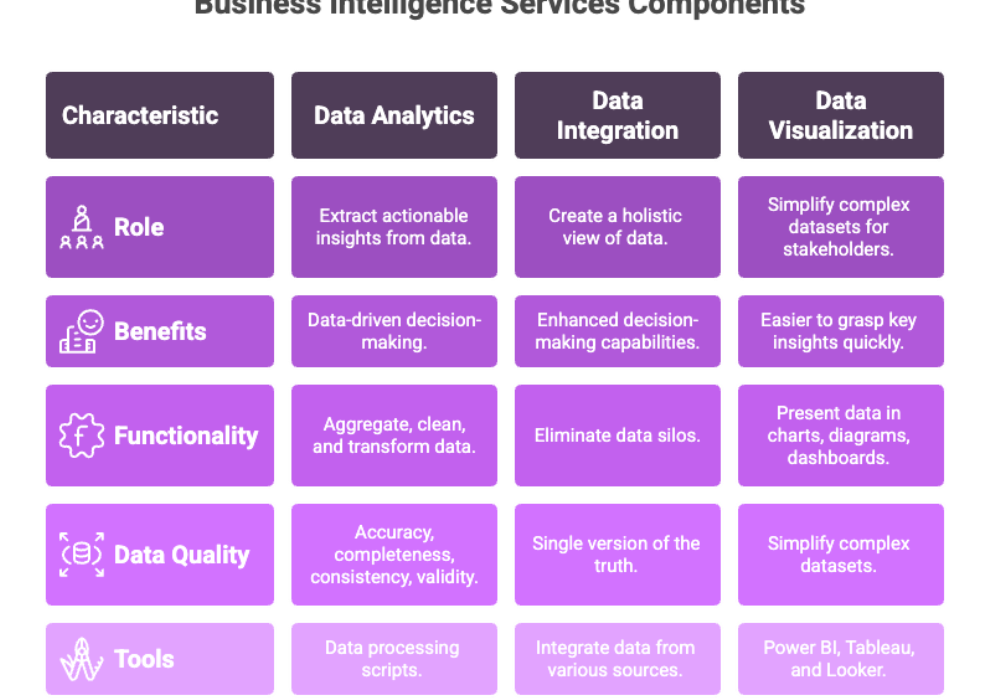

Key Components of Effective Business Intelligence Solutions
An effective BI architecture includes essential components like tools, benefits, and structured data management mechanisms. Key components of BI services include:
-
Data warehouses
-
Data quality management
-
Reporting
-
Business analytics These components work together to aggregate and analyze data from diverse sources, providing insights that facilitate process optimization.
Identifying inefficiencies and automating repetitive tasks can significantly streamline operations with BI services. Conducting a data assessment helps identify gaps in current data infrastructure and defines additional needs. These critical components are essential for building a robust BI solution.
Data Warehousing
Setting up a data warehouse aims to provide a reliable knowledge source that supports sophisticated analytics. Data warehousing enables:
-
Centralized storage of structured data for reporting and analysis, simplifying data retrieval processes.
-
Integration of data from various sources to create a master database.
-
Easier access and manipulation of information through the master database.
The database created by implementing data warehousing includes user interfaces for uploading and exporting data, improving usability. This centralization not only enhances data management but also supports advanced analytics, enabling organizations to make data-driven decisions with confidence.
Data Lakes
Data lakes facilitate the storage of large amounts of unstructured information, making it available for advanced analysis. A data lake allows for the data storage of vast amounts of unstructured data, providing flexibility for future analytics. The flexibility of data lakes enables businesses to adapt their analytical approaches as needs evolve.
These structures are crucial for leveraging advanced analytics capabilities to derive insights from unstructured data. Accommodating a wide variety of data types, data lakes empower organizations to explore new analytical possibilities and respond dynamically to changing business requirements.
Predictive Analytics
Predictive analytics in business intelligence forecasts trends and supports strategic planning through historical data analysis. This process utilizes historical data to identify trends and assist in strategic planning, enhancing decision-making. Business intelligence tools utilize advanced analytics to help organizations understand historical data and predict future trends.
Companies utilizing BI can identify market trends earlier than competitors, allowing for proactive strategies. Leveraging business intelligence allows companies to develop data-driven strategies that can significantly differentiate them from their competitors. This foresight enables businesses to stay ahead of market shifts and maintain a competitive edge.
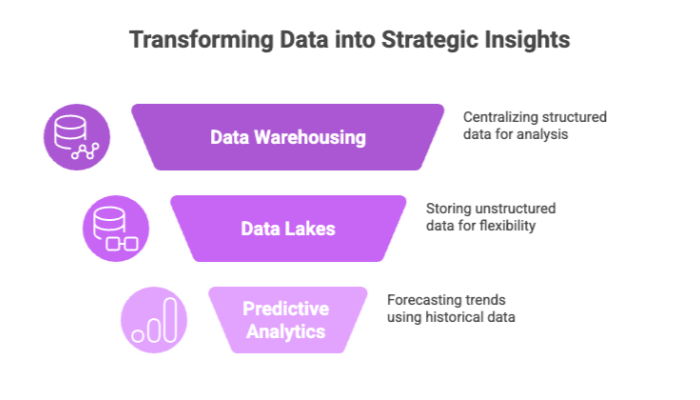

Enhancing Business Processes with Business Intelligence
Embedded Business Intelligence solutions assist users by:
-
Helping them make critical decisions and improve operations.
-
Leading to faster and more precise reporting, which enhances decision-making.
-
Providing customized dashboards with drill-down capabilities, enabling deeper analysis.
BI solutions deliver value across various management stages, including:
-
Planning
-
Performance monitoring
-
Decision-making
-
Process optimization
Accurate and easy-to-follow reporting helps businesses articulate the status quo and measure success by identifying new report opportunities. Let’s explore how BI enhances specific business processes.
Supply Chain Management
BI tools help companies in several ways:
-
Forecast demand more accurately, enabling better inventory management and logistical efficiency.
-
Enhance visibility across the supply chain, allowing better demand forecasting and inventory control.
-
Identify inefficiencies, enabling businesses to streamline processes and optimize resource allocation.
Business intelligence enhances decision-making by providing timely access to accurate data, enabling organizations to make informed choices. Data warehousing allows running queries and generating reports without disrupting day-to-day operations. This streamlined approach leads to improved productivity and reduced operational costs.
Financial Planning
Business intelligence supports financial management by:
-
Providing accurate data analytics for effective budgeting and forecasting.
-
Allowing organizations to track financial performance against key performance indicators, facilitating informed decision-making in financial strategies.
-
Improving financial planning accuracy by integrating real-time data for dynamic adjustments to forecasts.
BI tools provide insights that lead to more precise financial forecasts and improved budgeting processes. This data-driven approach ensures that financial plans are based on the most current and accurate information available.
Employee Performance
Business intelligence allows for the tracking of employee productivity through detailed analytics, enabling organizations to identify areas for improvement. Analytics from business intelligence helps organizations identify top performers and areas needing improvement among employees.
Detailed reporting provided by BI helps in assessing employee performance metrics, which can motivate targeted training and development programs. Tracking individual and team performance metrics with BI facilitates targeted improvement strategies, enhancing overall organizational productivity.
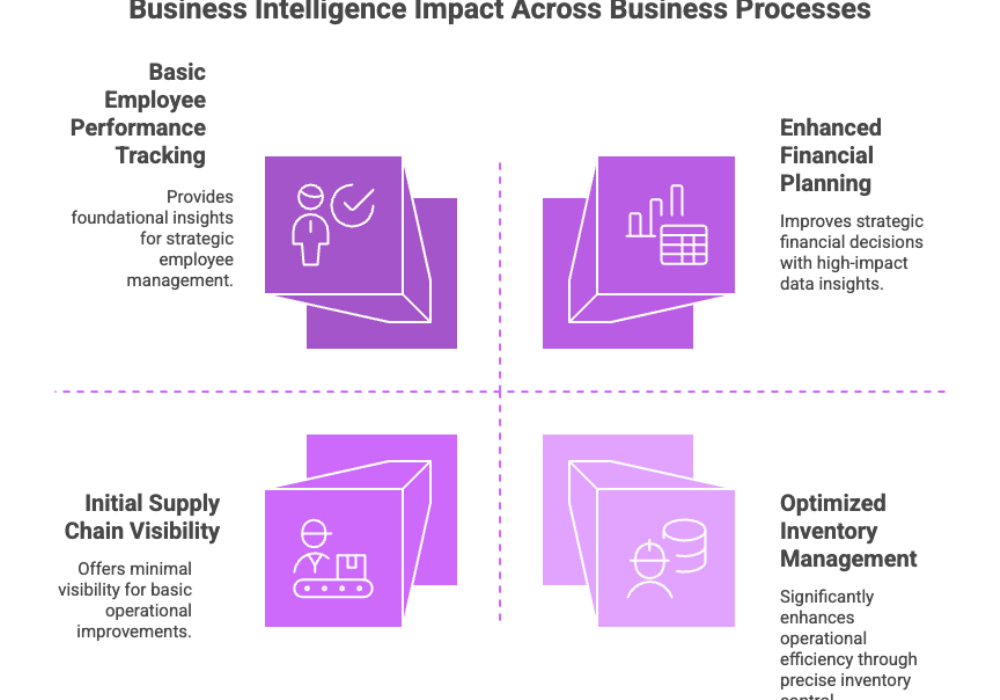

Implementing Business Intelligence Solutions
The implementation of business intelligence solutions is non-linear, starting from simple goals and refining the outcomes. Designing an effective data architecture is crucial as it forms the foundation for BI systems and impacts scalability and sustainability.
Successful implementation of BI systems often encounters issues such as resistance to change and lack of user training. Organizations often face resistance to change when implementing BI systems, which can hinder successful adoption.
A strong BI solution integrates various tools and methodologies to manage and analyze data effectively. Let’s delve into the steps involved in implementing BI solutions.
Gathering Requirements
The initial phase of implementing a Business Intelligence solution involves gathering requirements from business departments to ensure a tailored approach. Understanding customer needs is crucial; all potential requirements are considered from the onset to inform the BI project effectively.
Several key factors define the cost and complexity of BI implementation, including:
-
The number of users
-
Data sources
-
Data volume
-
Data cleansing complexity
-
Reports and analytics needs
-
Any machine learning algorithms required.
After completing the requirements gathering phase, a joint workshop is usually held to develop strategies for problem-solving and performance improvement.
Data Preparation
Data preparation is a crucial step in business intelligence that ensures data is ready for analysis. The processes involved in preparing data for analysis include:
-
Transformation
-
Cleaning
-
Normalization Normalization of data is essential as it ensures consistency across different data sources, allowing for more accurate analysis.
Meticulous data preparation ensures that the insights derived are reliable and actionable. This step lays the foundation for effective data integration and subsequent analysis, ultimately supporting better decision-making through data mining.
BI Tools Selection
When selecting BI tools, organizations must ensure they align with their business objectives and data management requirements. Popular tools like Microsoft Power BI offer robust capabilities for data visualization, interactive dashboards, and advanced analytics. These tools should be evaluated based on their ability to integrate with existing systems, user-friendliness, and scalability.
Selecting the right BI tools is a critical step in the implementation process. It ensures that the BI solution is effective and aligns with the organization’s long-term goals, providing the necessary support for data-driven decisions.
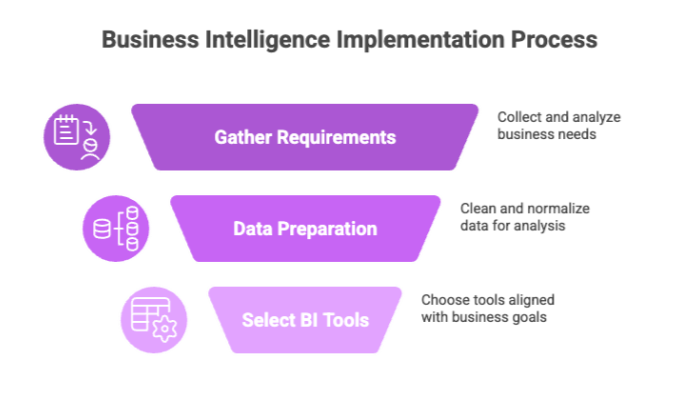

Case Studies: Real-World Applications of Business Intelligence
Business Intelligence services enable organizations to leverage data in ways that can address business problems and drive growth through informed decision-making. These case studies demonstrate how effective applications of Business Intelligence can result in improved operational efficiencies and increased profitability in diverse sectors.
By examining real-world examples, we can gain a deeper understanding of how BI solutions are implemented and the tangible benefits they provide.
Manufacturing Industry
An automated reporting system has been implemented to enhance management efficiency in the manufacturing sector. Business Intelligence and analytics systems have been built to provide decision support, improving informed decision-making. Operational efficiency is crucial in the manufacturing sector to reduce costs and improve productivity, alongside optimizing operational processes.
These advancements in operational efficiency and decision-making lead to better overall manufacturing effectiveness. The case study illustrates how BI tools can streamline processes and enhance productivity in the manufacturing industry.
Healthcare Sector
A dedicated client delivery team in healthcare BI handles change requests, code reviews, and product support, ensuring effective service delivery. Business intelligence services enhance patient care by providing actionable insights that improve treatment outcomes.
BI tools streamline operational workflows in healthcare by improving the efficiency of data handling and decision-making processes. Implementing bi expertise in healthcare organizations helps in identifying cost-saving opportunities through data-driven decision-making, including analyzing bi implementation costs.
This case study highlights the significant impact of BI on patient care and operational efficiency in the healthcare sector.
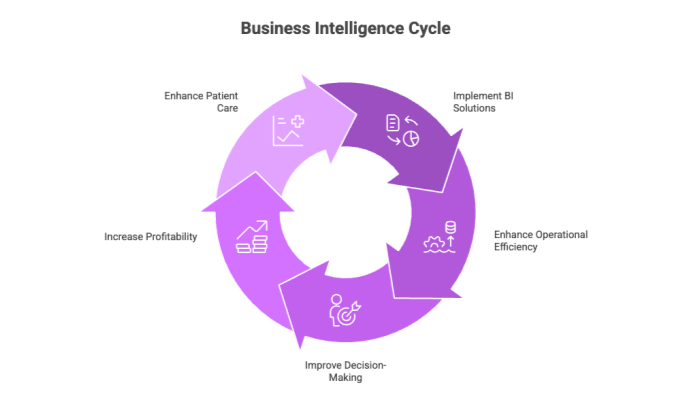

The Benefits of Reliable Business Intelligence Services
Companies leverage BI to gain a competitive edge by transforming raw data into actionable insights. Many businesses utilize BI to inform strategic decisions based on historical, current, and future data. Business intelligence tools focus on enhancing operational profitability. They also aim to address and solve real business issues through advanced data analytics.
The benefits of reliable BI services are manifold, ranging from improved decision-making and enhanced operational efficiency to gaining a competitive advantage. Let’s delve deeper into these benefits.
Improved Decision-Making
BI enhances decision-making by providing timely and relevant data, helping organizations understand their operations better. This helps make the right decisions at the right time. The robustness of data analysis and cost-effectiveness further support informed decisions.
Leveraging BI tools allows businesses to gain valuable insights, enabling swift responses to market changes and strategic moves that drive growth.
Enhanced Operational Efficiency
Implementing business intelligence in supply chain management offers several benefits:
-
Enhances visibility, allowing for real-time monitoring of logistics to quickly identify and solve issues.
-
Significantly improves supply chain visibility.
-
Reduces operational costs.
-
Improves inventory management.
Business intelligence streamlines operations by providing data-driven insights that reduce manual work and enhance productivity. This leads to more efficient and effective business processes, ultimately improving the bottom line.
Competitive Advantage
Businesses leveraging data-driven strategies are better positioned to outperform competitors and make informed decisions that drive growth. Data insights foster innovation by enabling companies to identify new market opportunities and developcutting-edge solutions.
Enhance customer experience through personalized insights helps retain customers and build brand loyalty, directly impacting competitiveness. Agility and responsiveness to market changes are crucial for businesses, and BI tools provide the necessary data to adapt quickly.
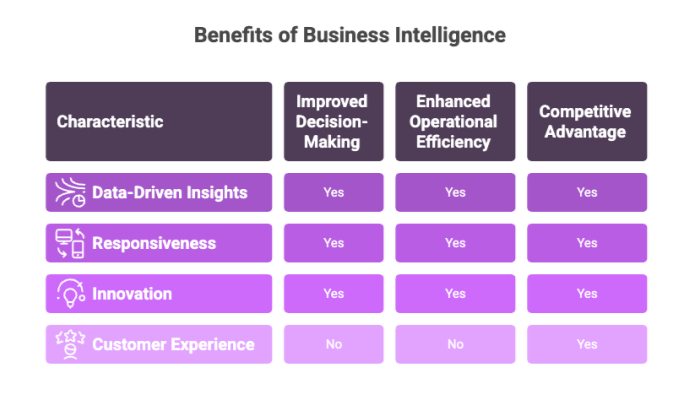

Addressing Common Challenges in Business Intelligence Implementation
Maintaining high data quality is crucial for effective Business Intelligence, as it ensures that insights derived from data are reliable and actionable. Encouraging user adoption of BI tools is essential to maximize their effectiveness; this can include user training, clear communication, and showcasing benefits.
Securing corporate data and ensuring compliance with data protection regulations is vital during Business Intelligence implementation to prevent data breaches and maintain trust. Addressing these challenges is key to the successful implementation and utilization of BI solutions.
Data Quality Management
Maintaining data accuracy and validity is crucial as it directly influences the reliability of insights derived from BI systems. Data quality management involves continuous monitoring and data governance to ensure that data remains reliable and fit for reporting, including quality control measures.
Consistently monitoring and improving data quality is crucial for maintaining trust in business intelligence insights. High-quality data forms the backbone of effective BI, enabling accurate and actionable insights.
User Adoption
Encouraging users to transition to BI tools often requires addressing their reluctance to move away from familiar applications. Involving end-users early in the BI implementation process can significantly enhance their commitment and comfort with the new tools.
Providing ongoing training and support for users is essential to increase the utilization of BI tools across the organization. This approach ensures that users are equipped with the knowledge and skills needed to leverage BI tools effectively.
Data Security
Implementing robust data protection measures helps safeguard sensitive corporate information and ensures compliance with regulations. Regular audits and assessments of security protocols are necessary to identify and mitigate potential vulnerabilities in BI systems.
It is essential to ensure that data is stored and transformed securely. Additionally, it is important to exploit it in a secure manner. This not only protects valuable corporate data but also maintains the integrity and trustworthiness of trusted data business intelligence systems.
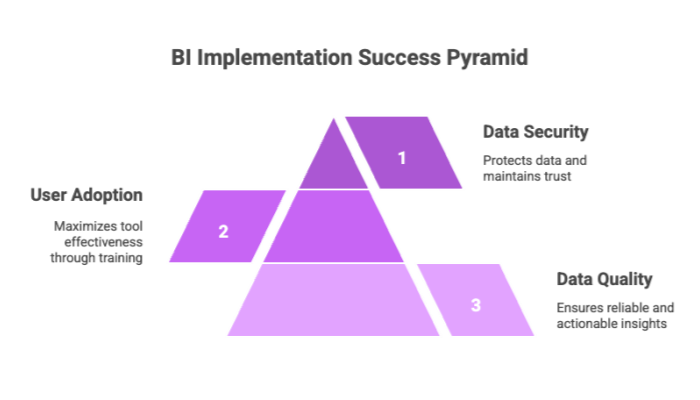

Summary
In summary, business intelligence services are indispensable for modern organizations seeking to leverage data for strategic decision-making and operational efficiency. By understanding the various components and benefits of BI solutions, businesses can transform raw data into valuable insights that drive growth and competitiveness.
As we have seen, implementing BI solutions involves careful planning and addressing challenges such as data quality management, user adoption, and data security. With the right approach, reliable business intelligence services can empower organizations to achieve their business goals and stay ahead in a competitive landscape.

Frequently Asked Questions
To help you better understand the value and application of business intelligence services, here are answers to some of the most common questions. These FAQs cover essential topics such as how BI solutions integrate data from various sources, support different user groups and user roles, and enable organizations to model data effectively.
Additionally, they highlight how BI tools help detect anomalies, deliver immersive reports and interactive reports, and support business decisions across industries. Whether you are considering implementing a new BI system or optimizing an existing BI solution, these insights will guide you through key concepts and practical benefits.
What are business intelligence services?
Business intelligence services enable organizations to extract knowledge from data and transform it into actionable insights, facilitating informed decision-making and comprehensive data analysis.
How does data visualization benefit businesses?
Data visualization benefits businesses by simplifying complex datasets, which allows stakeholders to quickly grasp key insights and communicate findings effectively. This clarity facilitates informed decision-making and enhances overall business performance.
What role does data warehousing play in BI solutions?
Data warehousing plays a critical role in BI solutions by providing a centralized repository for structured data, which simplifies data retrieval and enhances analytical capabilities. This foundational aspect supports comprehensive reporting and informed decision-making.
What are the common challenges in BI implementation?
Common challenges in BI implementation include maintaining high data quality, encouraging user adoption, and ensuring data security and compliance with regulations. Addressing these issues is essential for a successful BI strategy.
How can BI improve financial planning?
BI enhances financial planning by delivering precise data analytics that facilitate effective budgeting and forecasting, allowing for real-time adjustments to financial strategies. This integration of accurate insights significantly improves decision-making and financial management.

